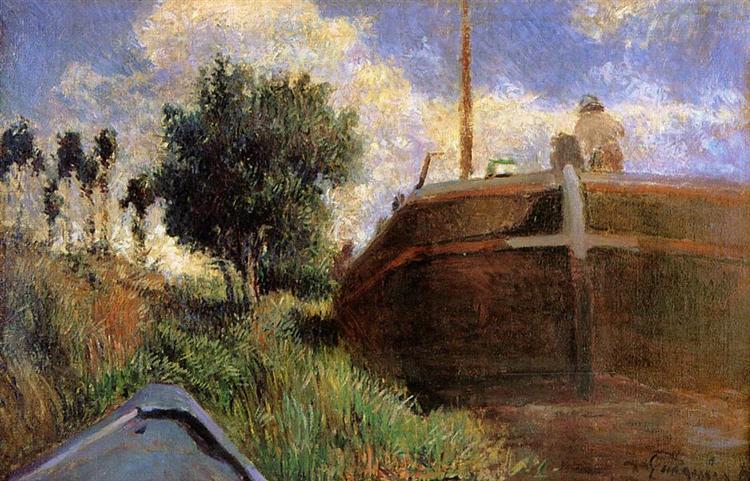Description
Paul Gauguin's "Blue Barge" (1882) is a captivating testament to the early artistic career of a master who would become a central figure in Post-Impressionism. In this painting, Gauguin explores the interplay between light and color, elements that would later define his distinctive style. The work evokes a melancholic atmosphere, capturing a moment suspended in time that suggests both serenity and introspection.
The composition of “Blue Barge” focuses on the figure of the boat, depicted with remarkable simplicity and yet with a monumentality that highlights its presence in the landscape. The barge, painted in a deep shade of blue, is situated in the foreground of the work, contrasting with a background of water that reflects lighter shades. This use of color symbolizes a search for harmony between the subject and its surroundings, a recurring theme in Gauguin’s work that can be seen in multiple pieces from his career, where nature and humanity coexist in a visual dance of shapes and tones.
Gauguin’s attention to the depiction of light is central to this work; warm and dark tones complement each other, creating a play of shadows that adds depth and dimensionality to the landscape. The sky in the background is painted in a softer blue than the barge, providing a continuity that connects the two elements. The juxtaposition of the vibrant blue of the boat against a more relaxed background introduces a dialogue between the artificial and the natural, a theme that resonates with Gauguin’s quest to explore the relationship between the individual and their environment.
There are no human figures in the painting, allowing the viewer to immerse themselves in the contemplation of the landscape and the object that inhabits it. This choice to omit characters can be interpreted as an approach to the idea of solitude and isolation, themes that Gauguin would explore in his later works. The boat, as a symbol, can represent the journey of life, the search for a destiny and, in a broader sense, the connection with the unknown.
Through "Blue Barge", Gauguin begins to break away from the conventions of Impressionism, focusing on individual expression and formal simplicity that would be characteristic of his future works. The use of unconventional colors, as well as the choice of subject matter, places him on the path towards symbolism, a movement in which artists of his time began to search for meanings beyond the merely visual.
In short, “Blue Barge” is a work that, while perhaps not as widely recognized as Gauguin’s other works, contains within its simplicity a vast field of explorations into color, light, and the sense of immensity that can be found in the landscape. This painting is a significant example of the evolution of an artist who, through his visual choices, offers us a window into his perception of the world, a precursor to the aesthetic quest that would ultimately lead him to his exotic Tahitian landscapes and his quest for primitivism. At its core, the painting remains a symbol of Gauguin’s personal and artistic journey, as much as a milestone in the art history of the late 19th century.
KUADROS ©, a famous painting on your wall.
Hand-made oil painting reproductions, with the quality of professional artists and the distinctive seal of KUADROS ©.
Painting reproduction service with satisfaction guarantee. If you are not completely satisfied with the replica of your painting, we will refund 100% of your money.

